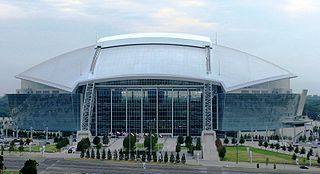Related Research Articles
John Calvin Portman Jr. was an American neofuturistic architect and real estate developer widely known for popularizing hotels and office buildings with multi-storied interior atria. Portman also had a particularly large impact on the cityscape of his hometown of Atlanta, with the Peachtree Center complex serving as downtown's business and tourism anchor from the 1970s onward. The Peachtree Center area includes Portman-designed Hyatt, Westin, and Marriott hotels. Portman's plans typically deal with primitives in the forms of symmetrical squares and circles.

San José Mineta International Airport — officially Norman Y. Mineta San Jose International Airport — is a city-owned public airport in San Jose, California. Located 3 mi (4.8 km) northwest of Downtown San Jose, the airport serves both the city and the Santa Clara Valley region of the greater Bay Area. It is named after San Jose native Norman Mineta, former United States Secretary of Transportation and United States Secretary of Commerce, who also served as Mayor of San Jose and as a San Jose City Councilman.

San Francisco International Airport is the primary international airport serving the San Francisco Bay Area in the U.S. state of California. It is located in an unincorporated area of San Mateo County.

San Diego International Airport is an international airport serving San Diego, California, United States. The airport is located three miles northwest of downtown San Diego. It covers 663 acres (268 ha) of land and is the third busiest airport in California in terms of passenger traffic. It is the busiest single-runway airport in the United States.
The Embarcadero in San Diego, California, is the area along the San Diego harbor on the east side of San Diego Bay. "Embarcadero" is a Spanish word meaning "boarding place". The Embarcadero sits on property administered by the Port of San Diego, in the Columbia district of downtown San Diego.

Embarcadero station is a combined BART and Muni Metro rapid transit subway station in the Market Street subway in downtown San Francisco. Located under Market Street between Drumm Street and Beale Street near The Embarcadero, it serves the Financial District neighborhood and surrounding areas. The three-level station has a large fare mezzanine level, with separate platform levels for Muni Metro and BART below. Embarcadero station opened in May 1976 – almost two years after service began through the Transbay Tube – as an infill station.

State Route 480 was a state highway in San Francisco, California, United States, consisting of the elevated double-decker Embarcadero Freeway, the partly elevated Doyle Drive approach to the Golden Gate Bridge and the proposed and unbuilt section in between. The unbuilt section from Doyle Drive to Van Ness Avenue was to have been called the Golden Gate Freeway and the Embarcadero Freeway as originally planned would have extended from Van Ness along the north side of Bay Street and then along the Embarcadero to the San Francisco-Oakland Bay Bridge.

The San Francisco Ferry Building is a terminal for ferries that travel across the San Francisco Bay, a food hall and an office building. It is located on The Embarcadero in San Francisco, California and is served by Golden Gate Ferry and San Francisco Bay Ferry routes.

Palm Springs International Airport, formerly Palm Springs Municipal Airport, is an airport two miles east of downtown Palm Springs, California, United States. The airport covers 940 acres and has two runways. The facility operates year-round, with most flights occurring in the fall, winter, and spring.

HOK, formerly Hellmuth, Obata + Kassabaum, is an American design, architecture, engineering, and urban planning firm. Founded in 1955, it is now registered as HOK Group, Inc.

HKS, Inc. is an American international architecture firm headquartered in Dallas, Texas (US).

People in the San Francisco Bay Area rely on a complex multimodal transportation infrastructure consisting of roads, bridges, highways, rail, tunnels, airports, seaports, and bike and pedestrian paths. The development, maintenance, and operation of these different modes of transportation are overseen by various agencies, including the California Department of Transportation (Caltrans), the Association of Bay Area Governments, San Francisco Municipal Transportation Agency, and the Metropolitan Transportation Commission. These and other organizations collectively manage several interstate highways and state routes, eight passenger rail networks, eight trans-bay bridges, transbay ferry service, local and transbay bus service, three international airports, and an extensive network of roads, tunnels, and bike paths.

The Port of San Francisco is a semi-independent organization that oversees the port facilities at San Francisco, California, United States. It is run by a five-member commission, appointed by the Mayor subject to confirmation by a majority of the Board of Supervisors. The Port is responsible for managing the larger waterfront area that extends from the anchorage of the Golden Gate Bridge, along the Marina district, all the way around the north and east shores of the city of San Francisco including Fisherman's Wharf and the Embarcadero, and southward to the city line just beyond Candlestick Point. In 1968, the State of California, via the California State Lands Commission for the State-operated San Francisco Port Authority, transferred its responsibilities for the Harbor of San Francisco waterfront to the City and County of San Francisco / San Francisco Harbor Commission through the Burton Act AB2649. All eligible State port authority employees had the option to become employees of the City and County of San Francisco to maintain consistent operation of the Port of San Francisco.

A floating airport is an airport built and situated on a very large floating structure (VLFS) located many miles out at sea utilizing a flotation type of device or devices such as pneumatic stabilized platform (PSP) technology.
A Pneumatic stabilized platform (PSP) is a technology used to float a very large floating structure (VLFS).

Seasteading is the creation of permanent dwellings in international waters, so-called seasteads, that are independent of established governments. No one has yet created a structure on the high seas that has been recognized as a sovereign state. Proposed structures have included modified cruise ships, refitted oil platforms, and custom-built floating islands.

Broadway Pier is a pier in San Diego, California, located on San Diego Bay at the intersection of Broadway and North Harbor Drive. It houses one of San Diego's two cruise ship terminals.

Fentress Architects is an international design firm known for large-scale public architecture such as airports, museums, university buildings, convention centers, laboratories, and high-rise office towers. Some of the buildings for which the firm is best known include Denver International Airport (1995), the modernized Tom Bradley International Terminal at LAX (2013), the National Museum of the Marine Corps near Quantico, Virginia (2005), and the Green Square Complex in Raleigh, North Carolina (2012).
The following is a list of transportation options in San Diego, California.

ROMA Design Group is an interdisciplinary firm of architects, landscape architects, and urban planners based in San Francisco, California, USA. It was founded in 1968 by American architect George T. Rockrise.
References
- ↑ ""Review of Alternative Air Carrier Airport Sites & Technologies", 1991, San Diego Association of Governments" (PDF). Archived from the original (PDF) on 2020-04-14. Retrieved 2012-10-21.
- ↑ "Friends of San Diego Architecture - "Donald Innis, Architecture-Inventor: A Floating Airport for San Diego"". Archived from the original on 2008-09-22. Retrieved 2008-08-13.
- ↑ "Floating Airport proposal Resurfaces", The San Diego Union-Tribune, By Alex Roth January 14, 2007
- 1 2 "Float Inc. "About Us"". Archived from the original on 2008-08-11. Retrieved 2008-08-13.
- ↑ Air History Org - Royal Flying Corps. People Index
- ↑ The London Gazette, October 29, 1918
- ↑ Canadian Great War Project - Alwyn Osman Innis
- ↑ Fort Rosecrans Nat'l Cemetery "Innis" Surnames "I" - Interment.net
- ↑ Canadian Department of Militia and Defence A.P. 9321-A-78 War Service Gratuity Records
- ↑ Encyclopedia of Chicago
- ↑ Encyclopedia of Chicago History
- ↑ www.autonmonparade.com
- ↑ "The Alaska Communications System" by B. McCalley
- ↑ Signal Corps Regiment Lineage in Alaska Archived 2008-06-21 at the Wayback Machine
- ↑ "General McArthur's Surrender Order to the Japanese" by Janice Reynolds Cook
- ↑ Army Communicator
- ↑ "History of the Atlantic Cable & Undersea Communications: U.S. Armed Forces Cables by Bill Glover
- ↑ Cable Laying and Repair Ships Archived 2008-05-09 at the Wayback Machine
- ↑ "Hans Albert Einstein Papers". Archived from the original on 2008-07-05. Retrieved 2008-08-13.
- ↑ C.J. "Pat" Paderewski 98; called S.D.'s 'Mr. Architect'" By Michael Kinsman San Diego Union Tribune July 12, 2007
- ↑ "Modern San Diego.com "C.J. "Pat" Paderewski"". Archived from the original on 2012-05-16. Retrieved 2008-08-13.
- ↑ San Diego Union, August 6, 1966, B-3:2-3
- ↑ "Flower Hill Project Description". Archived from the original on 2008-11-21. Retrieved 2008-08-13.
- ↑ “Master and Commander: The Far Side of the World” Premiere, Image Collect, November 9, 2003
- ↑ Getty Images - “Master and Commander: The Far Side of the World” Premiere, Image Collect, November 9, 2003
- 1 2 3 4 Offshore Ports, LLC
- ↑ Float Inc.
- ↑ “Floating an idea: airport on the water: Noted ocean scientist Walter Munk thinks it's the solution to future problem”, By Steve Chapple, San Diego Union-Tribune, September 21, 2013